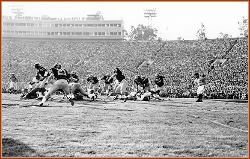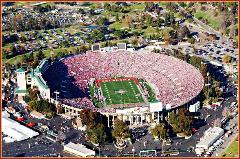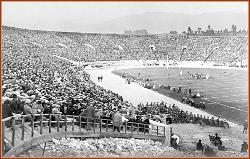








Camden Yards
It was the first, and thus one of the most highly praised, of the "retro" major league
ballparks constructed during the 1990s and early 2000s . It is situated in a picturesque
location, at the corner of downtown Baltimore and near the Inner Harbor.
History
In 1989, construction began on an all-new, baseball-only ballpark for the Baltimore
Orioles. Construction lasted 33 months on the ballpark, which finally opened on April 6,
1992, against the Cleveland Indians. After considerable debate on whether to name the
new ballpark "Oriole Park" or "Camden Yards"; former Orioles owner Eli Jacobs favored
Oriole Park while then-Maryland Governor William Donald Schaefer favored Camden
Yards; a compromise was reached to use both names.
The retro-style ballpark sparked a trend among other cities to construct more
traditional, fan-friendly ballparks in a downtown location. Prior to Camden Yards, the
predominant design trend of stadiums was symmetrical dual-purpose "concrete
doughnuts" located in the suburbs. The Orioles' previous home, Memorial Stadium, was
such a suburban "concrete doughnut."
Camden Yards hosted the 1993 MLB All-Star Game. On June 18, 1994, 43 fans were
injured in an escalator accident; one of the stadium's multiple-story escalators,
overcrowded with fans heading to their upper-deck seats, jerked backward, throwing
passengers to the bottom landing. On September 6, 1995, Camden Yards witnessed
Cal Ripken, Jr.'s record-setting 2,131st consecutive game (the layout of the playing field
was, in fact, somewhat designed to match Ripken's hitting style). Exactly one year later,
Eddie Murray blasted his 500th home run there.
Two orange seats stand out from the park's trademark sea of dark green plastic chairs.
One, located at Section 96, Row D, Seat 23 in the right-center field bleachers (officially
known as the Eutaw Street Reserve sections), commemorates the spot where Murray's
500th home run landed. The other, Section 86, Row FF, Seat 10 in the left-field
bleachers, was the landing spot for Ripken's 278th home run as a shortstop, breaking
Chicago Cubs legend Ernie Banks's record for the position. That home run was hit on
July 15, 1993. Ripken finished his career with 345 home runs as a shortstop and 431
overall.
The only no-hitter thrown at Oriole Park at Camden Yards to date was tossed by Hideo
Nomo, then with the Boston Red Sox, on April 4, 2001. Nomo faced 30 Orioles batters,
walking Mike Bordick twice and Chris Richard once, as the Red Sox won, 3-0.
Design
Camden Yards is built at the former location of a major rail station; its name derives
from the rail yards that were formerly on the site. The view from much of the park is
dominated by the former B&O warehouse behind the right-field wall. The stadium
planners incorporated the warehouse into the architecture of the ballpark experience
rather than tear it down or shorten it. The warehouse was has been hit on the fly only
once. Ken Griffey Jr. hit a blast that reached the wall, but not during a game - it was
during the Home Run Derby contest of the 1993 All-Star Game.
At street level, between the stadium and the warehouse, is Eutaw Street, which is
officially closed to all vehicular traffic. Along this avenue, spectators can get a view of
the game or visit the many shops and restaurants that line the thoroughfare, including
Boog Powell's outdoor barbeque stand. On game days, pedestrians must have a ticket
in order to walk on the part of Eutaw Street that is adjacent to the stadium, however on
non-game days the street is open to all while access to the stadium itself is blocked by
gates. Sections 90 - 98, called Eutaw Street Reserve, are located not in the stadium
itself, but rather adjacent to Eutaw Street, with the seats descending toward the outfield
below. If a game sells out, fans may purchase reduced-price "standing room only"
tickets which entitle them to enter Eutaw Street and watch the game from two
designated standing areas.
Many home run balls have landed on Eutaw Street, and the Orioles delightfully have
marked the spots with small baseball-shaped bronze plaques, embedded in the street
itself. Don't expect to see the latest home runs marked immediately, however, as it
sometimes takes up to a year for each homer to get a plaque.
On the street, there is also a statue done by sculptor Susan Luery of left-handed Babe
Ruth wearing a right-handed fielder's glove. The statue, created in 1996, is entitled
"Babe's Dream" and shows him at the beginning of his career, before left-handed
gloves (for the right hand of a fielder) were an option. The floors of the warehouse
contain offices, service spaces, and a private club.
The scoreboard advertises The Baltimore Sun at the top. The "H" in "The Sun" will flash
to show a scoring decision of a hit and the "E" will flash to show an error.
The stadium is the first major league park to have an outfield wall made up entirely of
straight wall segments since Ebbets Field. The playing field is 16 feet below street level.
Immediately adjacent to the current stadium is a rail station served by both the
Baltimore Light Rail and MARC commuter rail. The latter rail line provides direct service
to Washington, D.C., the former to BWI Airport.
The stadium is located in downtown Baltimore, near the Inner Harbor. The ballpark,
along with M&T Bank Stadium, home of the Baltimore Ravens of the National Football
League, make up the Camden Yards Sports Complex (the football stadium wasn't built
until 1998). Camden Yards is just a short walk from Babe Ruth's birthplace, which is now
a museum. Coincidentally, the location of his father's pub was where center field is
currently located on the playing field.
In May 2005, a new sports museum, Sports Legends at Camden Yards, opened in
Camden Station.









